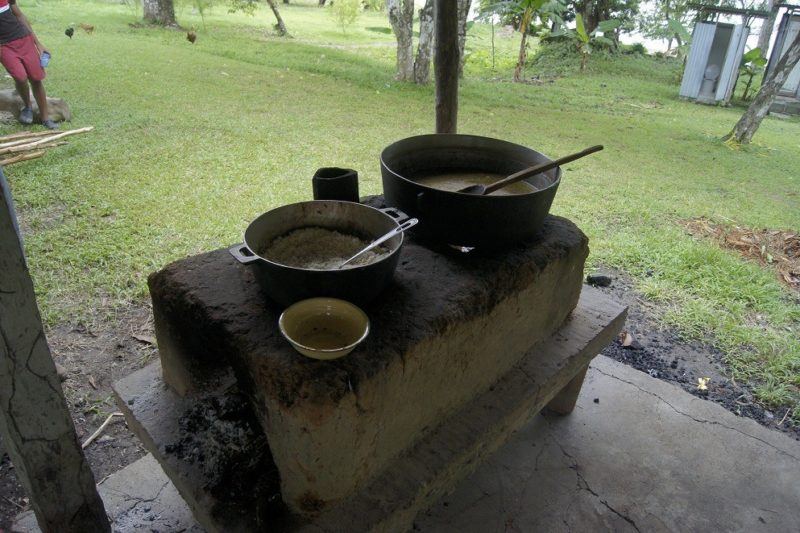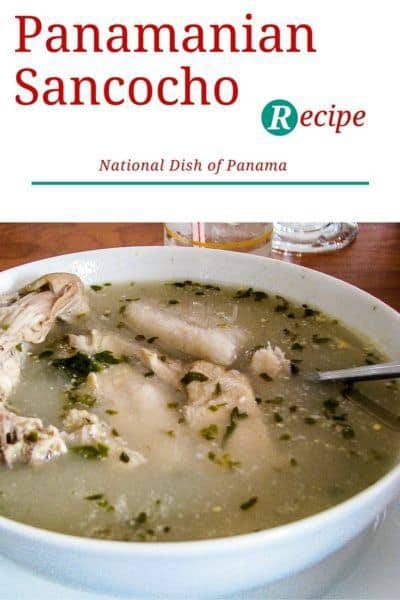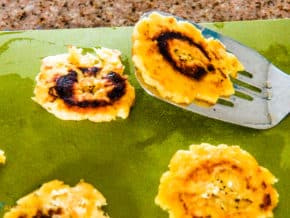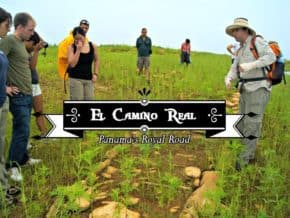There’s a reason sancocho is Panama’s national dish: One spoonful of this chicken-and-root-veggie stew, and you’ll swear it has healing powers. Locals eat it to recover from fiestas (we see you, rum lovers), colds, or just a long day. My first taste—in a tiny Casco Viejo café—was love at first bite. Now, I’m sharing the secret to making this cozy masterpiece at home.
I’m not sure if hot soup actually cools you down (Panama’s tropical logic!), but sancocho’s magic goes beyond temperature. It’s the ultimate cure-all—whether you’re battling a hangover from last night’s Abuelo rum or just need a taste of home. And trust me, once you try the campesino version (made with chickens that were roaming that morning!), you’ll never look at chicken soup the same way.
No matter where you travel in the world, chicken soup has a reputation for making people feel better. And it doesn't matter if it's Grandma's traditional Panamanian sancocho, made from scratch, or if it's just a store-bought can of Campbell's Chicken Noodle Soup.
Easy as pie? No, it's actually easier!
Maybe one reason sancocho has become Panama's national dish is because it's so incredibly simple to make. The most time-consuming part is peeling the root veggies.
The recipe for sancocho that we are sharing below serves about 6-8 people, depending on the amount of vegetables you use. To eat it the Panamanian way, it should be accompanied by a side of white rice. Panamanians will either mix the rice into the soup or take a bite with each spoonful.
Sometimes the soup is also accompanied by patacones. Super yum.
Panamanian Sancocho de Gallina
Equipment
- 1 large, heavy pot
Ingredients
- 1 chicken cut into pieces
- 1 Tbsp. oil your choice
- 3 garlic cloves pressed
- 2 Tbsp oregano
- 1 tsp black pepper
- 4 Tbsp culantro* chopped
- 1 large onion chopped into bite-size pieces
- 3 pounds starchy vegetables otoe, name/yams, yuca/cassava, green plantains**
- 2 ears corn broken into 1″ pieces
- 3 tsp salt to taste
- 8 cups water
Instructions
- Wash chicken and pat dry.
- Season the chicken with the garlic, oregano, and pepper.1 chicken, 3 garlic cloves, 2 Tbsp oregano, 1 tsp black pepper
- In a heavy pot, brown the seasoned chicken in the oil over a medium flame and allow to sweat.1 Tbsp. oil
- Meanwhile, chop the culantro. Set aside a small amount for garnish.4 Tbsp culantro*
- Add the rest of the herbs, onion, and water. Adjust water to cover the chicken.1 large onion
- Bring to a boil and reduce to a low simmer for 20 minutes.
- Meanwhile, peel the root vegetables and cut into bite-size pieces.3 pounds starchy vegetables
- After chicken has simmered for 20 minutes, add the root vegetables.
- Cook until everything softens, about one hour. Keep adding water so the veggies stay about an inch underwater.
- Add the corn and cook 15 minutes more, until corn is tender.2 ears corn
- Stir in salt to taste.3 tsp salt
- Garnish with the reserved chopped culantro/cilantro and serve
Notes

Our first experiences with Panamanian sancocho
I first tried sancocho at a little restaurant we found while we were wandering through Casco Viejo, Panama's old town. I kind of felt like I had to, since it's Panama's national dish. As soon as I saw the fresh culantro herb floating around on top, I figured it would be good. I wasn't disappointed.
Then we went on a day trip to visit the historic Camino Real, which lies on the outskirts of Panama City. Our guide brought us to a remote village, where we were served a home-cooked campesino meal. They had prepared a delicious lunch of traditional foods, cooked over an open fire on their community stove.
For me, the meal highlight came from a mega-pot of sancocho de gallina that had simmered on the stove for hours. Judging from their isolated location, they hadn't run down to pick up the meat at the corner store. it was obvious that the chickens in the pot had been running around earlier that morning. No wonder the other birds kept their distance from us!

Regional varieties of Panamanian sancocho
Every sancocho recipe is a little different, depending on the region and the chef. The color and flavor can vary a lot, anywhere from light brown to bright green, yellow, or orange.
The ingredients in the soup can vary in many ways, but all the varieties they serve in Panama share one characteristic: they are rarely spicy. We may be in Central America, but unlike Mexicans, Panamanians aren't very fond of picante foods. Sadly, that means that there aren't many hot peppers to be found in the grocery stores either. When we crave anything besides jalapeños and habaneros, it takes a trip to a specialty grocery to find them.
As for the regional differences in Sancocho recipes,
- The one they serve in Panama City is usually light brown because of the variety of root vegetables. Sancochos that are heavy in culantro have a bright, fresh flavor and a green hue. On the other hand, if you see a yellow or orange version, it's because the chef included a lot of squash (a.k.a. pumpkin) or yams.
- Sancocho chorrerano (made in the town of La Chorrera, outside Panama City) is a spicy exception, made of only chicken, onions, garlic, chili peppers, oregano, and ñame. I haven't heard of any other versions with a kick.
- There's another version made in Chiriquí Province, which borders Costa Rica; it's called sancocho chiricano (duh) and contains a laundry list of ingredients, including squash. (We haven't tried that one yet.)
By the way, if you're lucky enough to be served a bowl of the soup that was cooked over an open fire, your sancocho will pick up a hint of the smokiness. That adds another layer of flavor.
What is Panama’s national dish?
Panama’s national dish is sancocho de gallina, a hearty chicken soup made with ñame (yams), yuca, culantro, and corn. It’s prized for its restorative powers—locals eat it for hangovers, colds, or pure comfort.
What makes Panamanian sancocho unique?
Unlike other Latin American sancochos, Panama’s version is mild (not spicy) and gets its signature flavor from culantro, a bold herb similar to cilantro.
How do you eat sancocho like a Panamanian?
Always with a side of white rice (mixed in or spooned between bites) and sometimes patacones (fried plantains).
Is culantro the same as cilantro?
No, cilantro and culantro are not the same plant, even though they taste a bit alike. Cilantro has a delicate flavor, while culantro has a stronger flavor that holds up better during cooking. Culantro is a tropical herb with long, broad, saw-toothed leaves, while cilantro is the leaves of the coriander plant and looks similar to parsley. Panamanian sancocho gets its unique flavor from culantro. If you don't have culantro, you can substitute fresh cilantro, but you will have to adjust the amount.
Ready to make sancocho de gallina, Panama style?
Even if you haven't always harbored a secret desire to sample yucca or ñame, here's your chance to be a bit adventurous in the kitchen. If you're a daring cook, consider this a perfect opportunity to try a new veggie or two, because now you finally have a recipe that explains how to prepare it.
Please come back and rate our recipe after you make it!
Save this for later!
Pin this to your favorite Pinterest board.

Books about Panamanian cuisine:
- Flavors of Panama by Nilsa Lasso Lang
- Delectable Dishes of Panamanian Cuisine
- Recetas de mi suegra: Recipes from my mother-in-law (bilingual edition) by Pat Alvarado





I love Sancocho. I love it! but please, since we’re given a spoon to eat it with, cook that chicken until it’s falling- off- the- bone tender! Also, I can’t get the corn off of the cob with said spoon- is it just in there for flavor, or for eye appeal?
The Hotel Bambito, in Volcan, Chiriquí, made Sancocho that was to die for! Another very well recommended restaurant not too far away made it with the chicken too tough to eat, and huge chunks of corn. The broth was good, though, which was fortunate since that was about all that was tender enough to consume!
I’m really looking forward to learning to make the real deal here in New England, but I want to get it right with the ingredients. I think I can get the correct root vegetables in Spanish markets, as well as the Culantro, which isn’t too common around here. Any advice would be great!
We’ve wondered the same thing about the corn cob, Ellen. Could be it adds a subtle sweetness or a different texture, or looks, but no one’s told us why it’s in there. Though come to think of it, we’ve seen people unabashedly fish it out with their sppoon and eat it with their fingers. So who knows?
If you have access to a Spanish market you shouldn’t have any problem finding all the authentic ingredients you’ll need. Cilantro is an acceptable substitute, but culantro should be availbale. It’s a key ingredient in recaito (a traditional base of onion/garlic/bell pepper). If you can’t find one of the ingredients, just remember that recipes vary a lot, so you’ll still be making the real deal. We’d love to see a photo and let us know how it turns out!
After living and repeatedly revisiting Panama in the early ’90’s, I got back to AZ and searched for several exotic ingredients: aji chombo, culantro, & some still-unidentified soapberry fruit, similar to lychee, but with tasty, edible pits. After exhaustive research, it turned out that the aji & culantro were completely unavailable, even from CA-based specialty produce brokers. At that time, even Habaneros were non-existent in the West – period. So, there was no way for me to make my beloved orange, mustardy aji chombo hot sauce, which is so ubiquitous at roadside charcoal-grilled chicken around Panama City. Many years later, Habaneros became available at Mexican-oriented markets, and now there’re even at Kroger, etc! So, now, to my fellow foodies delight, I can make that salsa. But back to culantro/recao. For years, coriander/cilantro made a very satisfactory substitute, in my opinion. No other herb even comes close. However, now, with the explosion of Asian markets in the PHX area, culantro (or sawtooth herb) is readily available, and the price is really reasonable for a formerly-rare & exotic herb. For more info on Ngo Tau, see this excellent website: http://vietworldkitchen.typepad.com/blog/vietnamese-herb-primer.html It’s so exciting to have culantro available for so many recipes in the world’s recipes! P.S. I never did figure out what that fruit was. Lychee? Longan? I just dunno’…
Thanks for your comment, Kenton. We hear you on the habanero; it has a unique heat and is now pretty easy to find in American grocery stores. Unfortunately, we haven’t found many stores that carry culantro; it seems you have to go to areas that cater to Asian or Latin clientele, because they know how to use it in recipes. By the way, culantro is sometimes called Mexican coriander or sawtooth herb, so keep that in mind if you want your grocer to order some for you.
Panamenian sancocho is always super delicious. I get it every time I go to Panama. I even make it at home. It is the best. I used also if anybody at my house is about to get sick with the flue.
Really, Elena? That’s super cool. Since recipes are so different, may we ask how you prepare yours?
is that 2T dried or fresh oregano?
Yikes! It’s fresh oregano. (Or since 1 Tbsp. of finely chopped fresh oregano = 1 tsp. of dried oregano, that would be 2 tsp. of dried oregano.)
Omigosh, Ellen, that much dried oregano would overwhelm everything else. Thanks for pointing out my oversight; I’ve edited the recipe.
This one is very similar to the one prepared in Puerto Rico. We use beef instead of chicken and tomato sauce is added (that will change the color of the broth). But, it is all about those delicious root vegetable. Sancocho is good no matter the recipe.
I didn’t know that a beef-and-tomato-based sancocho exists. It sounds delicious, though. I’ll look for it the next time we are on the island. What seasonings are most commonly used in Puerto Rican sancocho?
Cure for hangover, yes I believe that. We have a similar dish in the Philippines and we do always eat it after a full night of drinking.
Really? Cool! What’s the Philippine dish called?
Thanks for the tip on an alternative to the herb Culantro, there was no way I was going to find it here in Australia 🙂
As we are heading into winter here I am on the search for new soup recipes so will give it a go.
Lovely, Sally. If you think of it, please come back and let us know how it turns out.
I’ve never heard of the dish, but it looks delicious and very healthy, too.. I’m not a fan over overly spicy food, so I think that this would suit me just fine. How similar in taste are culantro and cilantro? I haven’t heard of the culantra before. When we lived in Malaysia, I had to remember to ask for coriander at the market when I wanted cilantro.
Michele, I think you’re right because – lol – it’s a chicken soup and mom always gives us healthy stuff, right?
Culantro is sometimes called spiny cilantro but its leaves look quite different and its flavor isn’t the same. They use it in some southeast Asian dishes as well as in Latin American cuisine and yes, you can use one if you can’t find the other.
This looks absolutely delicious. I must give it a try. I love trying the local food when I’m travelling and your experience of tasting the home-made soup in a remote village is exactly the sort of thing I’d love to do. Thanks so much for the tip.
We like to try local foods as well. Glad you enjoyed our story.
All this food this week, yum! I love lots of regions use the basic chicken soup and give it a local touch. Sounds and looks delicious and I’m sure glad I’ve had my breakfast or I’d be drooling over my keyboard.
It’s really good, Lyn, and you’re right how every region has its own twist on chicken soup. I haven’t yet seen a recipe that didn’t look delicious.
Ooooh, that looks SO good! 🙂 I am a sucker for soups anyway, so I’m whipping this up over the weekend. It seems similar to Sopa de Lima (which I learned about in the Yucatan); it uses most of the same ingredients but adds lime. Also tasty! 🙂 Thanks for the recipe!
You’re welcome. If you do end up making it, please do let us know how it turns out.
If sancocho is the Panama’s national dish you definitely had to try it, Linda. I looked at the recipe and it’s very different from what I use in my chicken soup, so I’m sure it tastes differently. I’d like to try it though, it looks delicious. Chicken soup is known to be a cure for many ‘conditions’ and a hangover is one of them. My mother used to give it to us as kids whenever we had high fever and the soup worked miracles. It’s probably all the healthy ingredients that you use in the soup that nourish your body back to health. I’m sure it must have been a very interesting experience to live in Panama.
Really, Anda? So did mine. We had good moms. What goes into Romanian chicken soup? I would really like to try it.